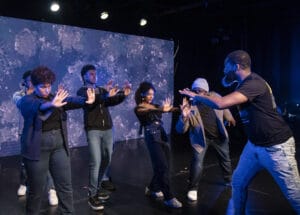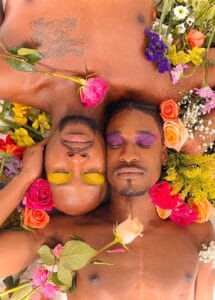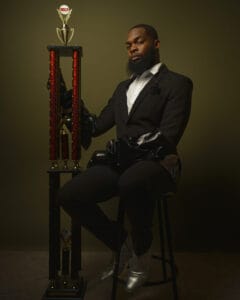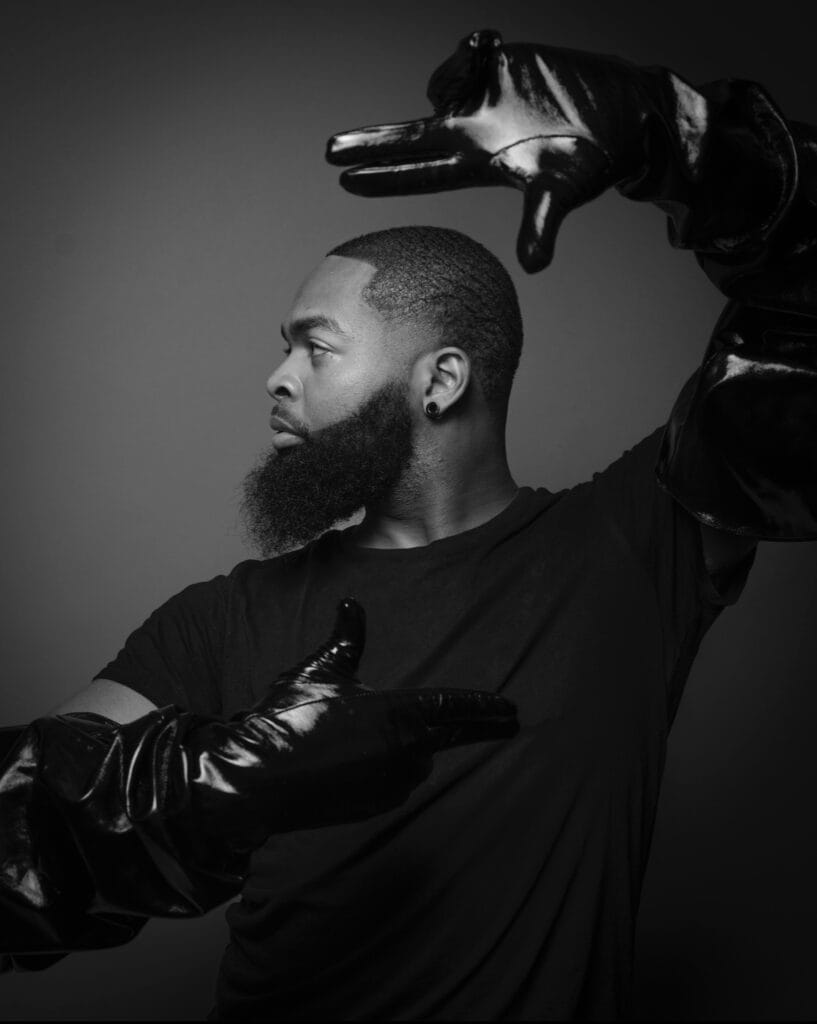As part of our ongoing “Voices of the Industry” series, which amplifies the stories of trailblazing queer people of color in the entertainment industry, we’re thrilled to introduce Kemar Jewel. A dynamic Black Queer director, choreographer, and artist, Kemar’s work sits at the intersection of ballroom culture, Black queer identity, and the transformative power of performance. Known for his visionary artistry and deeply personal storytelling, Kemar draws inspiration from his Caribbean roots, his experiences within the vibrant ballroom scene, and his commitment to expanding representation in media.
Kemar Jewel is a multifaceted artist whose career spans a variety of creative spaces, including theatre, dance, opera, music videos, and live tours. Raised in Philadelphia and now pursuing an MFA in Directing at Yale’s prestigious David Geffen School of Drama, Kemar’s artistry is a fusion of his lived experiences and his passion for revolutionizing the way we see ourselves on stage and screen. A proud member of the Legendary House of Lanvin and an alum of the Drama League Fellowship, Kemar’s mission is to recontextualize classic stories, making them reflective of the diverse voices and experiences that define our society today. His work consistently showcases the magic of Blackness and Queerness through theatre, music, and dance, creating art that both challenges and celebrates the boundaries of performance.
Beyond his work as an artist, Kemar is a passionate educator and community leader, using his platform to teach workshops and masterclasses on dance, theatre, and Black Queer history at institutions such as Temple University, NYU, and The Franklin Institute, among others. As the founder and artistic director of Xcel Dance Crew, a performance group that blends voguing with other dance styles, Kemar continues to shape the future of dance and performance.
In this installment of our series, we explore how Kemar’s creative journey was sparked by a chance encounter, the importance of diversity in Black queer media, and the deeply personal connections that drive his artistry—most poignantly through his recent tribute to the late O’Shae Sibley, a rising star in the ballroom community whose life was tragically cut short. Kemar’s tribute to O’Shae speaks to the very core of his work: the power of dance as both a means of expression and a tool for resistance, especially in the face of violence against Black and LGBTQ+ communities.
View this post on Instagram
GLAAD: Kemar, thank you for taking the time to talk with us today. We’re honored to learn more about your journey and creative work. Can you start by sharing how you got your start in the industry?
Kemar Jewel: Thank you for having me, it’s a pleasure to be here! My career actually started by accident. I was in undergrad, taking a class where we were asked to create a piece of art that represents us and our community. I knew I wanted to do something different but had no idea what. Then, one day, I was on the train, and a song called Voguing Train came on my playlist. I thought, “What are the odds that I’m on a train listening to a song about voguing?” That moment of divine timing sparked an idea to create a video where people actually vogued on a train. I made it happen, and when I showed it to my mentors, they told me it was great and that I should put it on YouTube. I thought it was silly, but I did it anyway. Next thing I know, it went viral, and I realized that creating art for and about Black Queer and Trans people, especially in the Ballroom community, was what I wanted to do. I love showing the beauty, depth, creativity, and brilliance of my community.
GLAAD: How do your identities, particularly being Black and LGBTQ+, shape your work in media, and how do you feel your art amplifies Black queer voices?
Kemar Jewel: My identities are at the core of everything I create. As a Black Queer person, I’m very aware of the stereotypes that are often imposed on us, and I make it a point to show that we are not a monolith. My work is about breaking down those assumptions and showing different sides of the Black Queer experience. What brings me the most joy is when I hear from Black Queer and Trans people—whether they’re in small rural towns or countries where being queer is illegal—telling me that my work has inspired them or brought them joy. It’s truly a gift to know that my art resonates and helps people feel seen, especially in places where our stories aren’t always heard.
Creating a legacy is important to me, and I’m proud of the visual stories I’ve crafted, knowing they’ll be referenced for years to come. It’s all about creating a space for Black Queer joy, pride, and resilience.

GLAAD: You’ve mentioned the importance of showing the diversity within the Black Queer community. Could you speak more to that?
Kemar Jewel: Absolutely. One of the things that’s often overlooked is that our community has so many layers. As Black Queer people, we’re often reduced to just a couple of narratives—usually centered around trauma or tragedy—but we are so much more than that. I want to see stories where we’re allowed to live, love, laugh, and exist just like anyone else. We deserve to see our stories told in all their complexity, not just through the lens of pain or oppression. I want a Black Queer sitcom. I want a Black Queer legal drama. Why not? We deserve to see stories that reflect the full spectrum of our lives, just like our straight and white counterparts do. Our narratives should be as diverse and expansive as the people who live them.

GLAAD: Who are the artists, creatives, or industry professionals who inspire you? And are there any current works you’re engaging with that inform your art?
Kemar Jewel: Oh, I have so many inspirations! First, I have to mention Tarell Alvin McCraney—his work in plays like Choir Boy and the Oscar-winning Moonlight has had a huge impact on me. The way he captures Black Queer identity with such nuance and honesty is something I strive for in my own work. Patrick-Ian Polk’s Noah’s Arc was also monumental for me. That was the first time I saw myself represented positively on screen. It gave me hope for my own future and showed me that love, joy, and opportunity were possible for Black Queer people.
Right now, I’m obsessed with Black Queer playwrights like Jordan E. Cooper and Donja R. Love, and Black trans activists and artists like Qween Jean and Gia Love. Their work is so powerful and fuels my passion to keep creating art that gives back to my community.
I’m also a huge fan of The Read podcast—they just get me with their humor and perspective on the world. Lately, I’ve been watching a lot of anime and magic-related shows, as I’m a self-proclaimed Black Queer nerd. I love embracing that part of myself. And I’m re-reading One Day My Soul Just Opened Up—it’s been a life-changing book for me, always helping me center myself when things get chaotic. Plus, therapy is key!

GLAAD: You recently finished a deeply personal project honoring your late friend and colleague, O’Shae Sibley. Can you tell us about that project and what it means to you?
Kemar Jewel: O’Shae and I were chosen family. We met over a decade ago, and we bonded quickly because we were both tall Black gay men who loved to dance. O’Shae was more than just a talented dancer; he had an infectious spirit. He always encouraged everyone to stay positive, no matter the adversity. It’s still hard to believe he’s gone.
I’m honored to finish the project that O’Shae was so excited to work on. He was a key part of my creative process, appearing in over seven of my videos. He loved voguing and was such an important figure in the ballroom scene. His tragic death last year, while voguing to Beyoncé’s Renaissance, was a devastating blow to all of us. This project, which pays tribute to O’Shae and his love for ballroom, is my way of ensuring that his legacy continues. He was more than just a dancer; he was a symbol of joy, resilience, and love, and I want the world to see that through this project.
GLAAD: With his untimely passing and the ongoing fight against anti-LGBTQ violence, what do you hope people take away from your work and his story?
Kemar Jewel: First and foremost, I hope people remember O’Shae for who he truly was: a kind, loving, goofy, funny, and unapologetically Black Queer man. He was more than just the circumstances of his death. He was a friend, a brother, an artist, and a light in so many lives. I want people to see the joy in his legacy. I hope a young Black boy watches this tribute and is inspired to be himself, to express his identity, and to pursue his dreams. O’Shae embodied love and unity, and that’s something I hope we all take to heart.
O’Shae’s death is part of a larger conversation about the ongoing violence and discrimination that Black Queer and Trans people face. We have to remember that these lives matter, and that joy and resistance are intertwined. Ballroom culture, dance, and expression have always been forms of resistance. For O’Shae, voguing wasn’t just a dance—it was an act of defiance against a world that tries to silence us.

GLAAD: What’s next for you, Kemar? What projects do you have in the works?
Kemar Jewel: I’m currently finishing my final year in the MFA Directing Program at Yale University. For my thesis, I’m directing ‘Ain’t No Mo’ by Jordan E. Cooper. I’m also excited to release the project honoring O’Shae Sibley, which is deeply personal for me. On top of that, I’m starting a new video project focused on energizing Black Queer and Trans folks to vote and support Kamala Harris. I want to create art that empowers my community in every way possible.
Be sure to follow Kemar’s journey on Instagram at @Kemar_jewel and keep up with his work through his website at KemarJewel.com. And stay tuned for more inspiring stories and insights from trailblazing LGBTQ creatives of color on“Voices of the Industry”.
_____________________________________________________________________________
About O’Shae Sibley:
As Kemar continues to create work that uplifts and celebrates Black queer and trans lives, one of his most recent projects is deeply personal: a tribute to his beloved friend and fellow dancer, O’Shae Sibley. O’Shae was tragically murdered on July 29, 2023, at a Brooklyn gas station after performing a joyful voguing routine to Beyoncé’s Renaissance in public, an act of self-expression and celebration of his identity. He was fatally stabbed by a 17-year-old, who has since been arrested and charged with murder as a hate crime.
O’Shae’s passing is a painful reminder of the deadly violence that continues to affect the LGBTQ+ community, particularly Black, queer, and trans individuals. As Kemar reflects on his late nephew’s legacy, he reminds us of O’Shae’s irrepressible joy and optimism, even in the face of adversity. O’Shae’s death not only highlights the ongoing threat of anti-LGBTQ+ violence, but also the resilience and strength of the ballroom community, who continue to use dance and performance as a form of resistance against hate and oppression.
In honoring O’Shae’s memory through his artistry, Kemar is not only celebrating his legacy but also creating a platform for greater visibility of the LGBTQ+ community in all its complexity. As we look toward the future of Black queer representation in media, Kemar’s work stands as a testament to the magic of Blackness, queerness, and resilience in the face of violence and loss.
As Kemar shared, his hope is for young people, particularly Black and LGBTQ+ youth, to see themselves in the work, and for O’Shae’s story to inspire others to live authentically and boldly. In a world where so many queer lives are still targeted simply for existing, the power of art—especially through dance and performance—is a way to continue the fight for love, acceptance, and justice.













